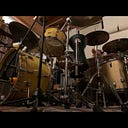Are You Hip To…Keef Hartley?
The drummer for the band that bore his name played at Woodstock and helped put progressive rock on the map.
Beatle fanatics, being Beatle fanatics, may scoff at those unfamiliar with the name Keef Hartley, but you won’t be treated so sternly here. While the drummer who replaced Ringo Starr in his pre-stardom band, Rory and the Hurricanes, is no doubt the subject of hundreds of footnotes in The Library of Beatledom, Hartley and the band he led remain largely unknown today, even among fairly learned rock fans. This despite being a prime mover in the same scene that spawned the Rolling Stones, Fleetwood Mac, and the other architects of classic British rock, and despite directly helping move the music in a more sophisticated direction.
Hartley was born in Preston, England, in 1944 and took drum lessons from Lloyd Ryan, Phil Collins’ early drum tutor. His first notable band was the popular Liverpool act Rory and the Hurricanes, which he signed up with soon after Ringo Starr left the group to officially join the soon-to-be Fab Four. Subsequently Hartley moved to London and joined the Artwoods, which included future Deep Purple keyboardist Jon Lord. Around this time the drummer also began doing sessions.
Like the Hurricanes, the Artwoods couldn’t turn their positive live reputation into record sales, though their sides hold up extremely well alongside those of similar-minded groups of the day, such as the Animals and the Yardbirds. While a clean vinyl copy of the group’s 1966 LP, Art Gallery, could cost you a couple hundred bucks (a 1995 reissue would be far lighter on the wallet), The Very Best of the Artwoods, which collects all their singles and B-sides, is widely available and stream-able. These recordings show Hartley to be a powerful, soulful player, authentic enough to mimic the American groups so beloved by the British Mods, but flexible and supportive of the band’s more adventurous proclivities, such as on the oddball track “Molly Anderson’s Cooking Book” and the tom-fueled proto-psych number “In the Deep End.”
The Artwoods were history by 1967, but by the end of the year Hartley could be heard (alongside a young, pre-Stones Mick Taylor) on Crusade by John Mayall’s Bluesbreakers. Hartley was the famed multi-instrumentalist’s only musical cohort on the well-regarded ’67 solo release The Blues Alone, appeared on the Bluebreakers’ two-volume live album Diary of a Band, and played on one track on their 1968 swan song, Bare Wires. The drummer on the rest of that album, Jon Hiseman, would form the influential jazz-rock band Colosseum that same year. Hartley showed that he had similar musical ideas when, after his stint with Mayall, he founded his own act, which layered its soul and blues base with Cream-like intensity and an explorative bent reminiscent of Traffic. Their sound had American audiences comparing them to groups like Blood, Sweat and Tears; from a 2021 perspective they sound like a more aggressive Chicago.
Harfbreed, the Keef Hartley Band’s 1969 debut, featured a two-trumpet/two sax horn section and began to make enough noise to earn them an invite across the pond, to the Woodstock festival in upstate New York. The first British band to take the stage at the three-day event, they hit on Saturday afternoon, an hour or so after Santana. That band’s iconic performance, featuring Michael Shrieve’s electrifying drum solo on “Soul Sacrifice,” would be a highlight of the Woodstock feature film and help jumpstart their career.
Unfortunately Hartley and company would enjoy no such advantage, since their manager pushed his luck too far by insisting on being paid in advance for the rights to the band’s inclusion on the Woodstock movie and its soundtrack LPs. To be fair, no one at the time would have known what a cultural touchstone the festival would become — the film played a big part in that — but woulda-shoulda-coulda still must have been a bitter pill for Hartley to swallow for many years after.
The drummer plowed ahead, though, treating his ensemble less like a traditional pop group and more like a jazz band, with an intentionally fluid lineup. In a post-Halfbreed interview included on the wonderful live collection British Radio Sessions 1969–1971, Hartley provided hints to his ambitions for the group, stating that not only would the next studio album include an extended horn section, but that he was planning a live performance that would feature an even larger lineup.
While subsequent Keef Hartley Band albums continued to garner strong reviews, and the drummer freelanced with other artists including the great singer/songwriter Michael Chapman, mass acceptance continued to elude him, and he was essentially out of the rock scene by the mid-’70s. The Hartley Band’s lost Woodstock appearance would finally be made available on the 2019 set Back to the Garden, though the leader, who passed away in 2011, was sadly never able to appreciate it.
As a drummer, Hartley didn’t possess the head-spinning qualities of Led Zeppelin’s John Bonham, the dramatic impact of Jethro Tull’s Clive Bunker, the unpredictability of the Who’s Keith Moon, or the unique rhythmic voice of Cream’s Ginger Baker. But he was certainly as accomplished as many players of the day who enjoyed much more fame and fortune, and his bands were among the toughest and most creative of the era. Perhaps his true value should be considered his willingness to lead from behind the drums, which few others of his time — Hiseman and Aynsley Dunbar come to mind — dared to attempt. And certainly his musical ambitions of broadening the soul and blues palette of swinging London to take in psychedelia, jazz, and folk elements were influential on an entire generation of rock musicians.
